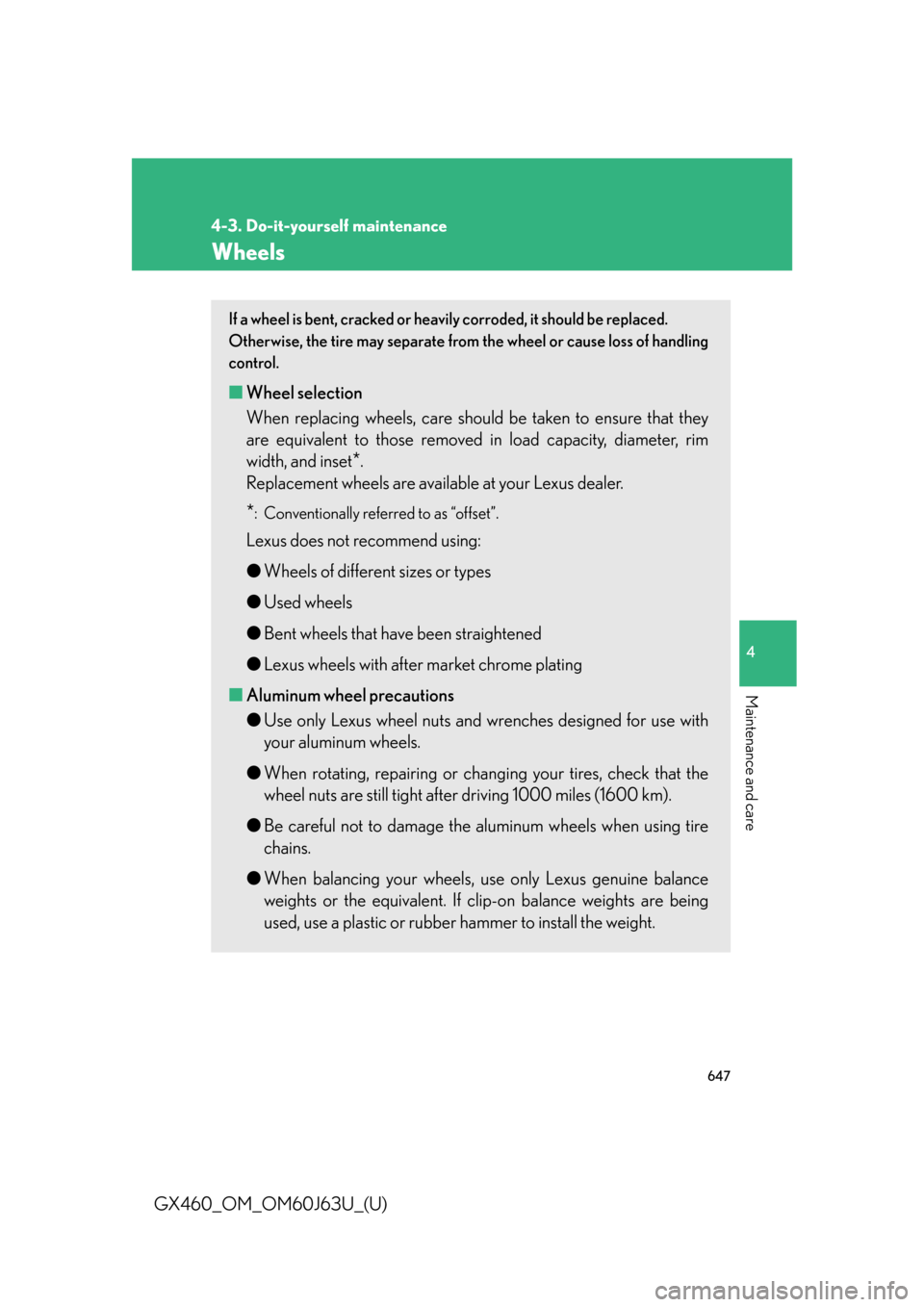load capacity Lexus GX460 2013 Specifications /
[x] Cancel search | Manufacturer: LEXUS, Model Year: 2013, Model line: GX460, Model: Lexus GX460 2013Pages: 844, PDF Size: 10.42 MB
Page 345 of 844

345
2-4. Using other driving systems
2
When driving
GX460_OM_OM60J63U_(U)
CAUTION
■TRAC/Active TRAC may not operate effectively when
Directional control and power may not be achievable while driving on slippery road
surfaces, even if the TRAC/Active TRAC is operating.
Do not drive the vehicle in conditions where stability and power may be lost.
■Hill- start assist control does not operate effectively when
Do not overly rely on the hill-start assist co ntrol. The hill-start assist control may not
operate effectively on steep incl ines and roads covered with ice.
■When the VSC is activated
The slip indicator light flashes and a warning buzzer sounds. Always drive carefully.
Reckless driving may cause an accident. Ex ercise particular care when the indica-
tor light flashes and a buzzer sounds.
■When the TRAC or Active TRAC/VSC systems are turned off
Be especially careful and drive at a speed appropriate to the road conditions. As
these are the systems to ensure vehicle stability and driving force, do not turn the
TRAC or Active TRAC/VSC systems off unless necessary.
■Replacing tires
Make sure that all tires are of the same size, brand, tread pattern and total load
capacity. In addition, make sure that the tires are inflated to the recommended tire
inflation pressure level.
The ABS/Multi Terrain ABS and VSC systems will not function correctly if different
tires are installed on the vehicle.
Contact your Lexus dealer for further info rmation when replacing tires or wheels.
Page 363 of 844

363
2-5. Driving information
2
When driving
GX460_OM_OM60J63U_(U)
Cargo and luggage
Take notice of the following information about storage precautions, cargo
capacity and load:
●Stow cargo and luggage in the luggage compartment whenever
possible.
● Be sure all items are secured in place.
● To maintain vehicle balance while driving, position luggage evenly
within the luggage compartment.
● For better fuel economy, do not carry unnecessary weight.
Page 364 of 844

364
2-5. Driving information
GX460_OM_OM60J63U_(U)
Capacity and distributionCargo capacity depends on the to tal weight of the occupants.
(Cargo capacity) = (Total load capa city) — (Total weight of occupants)
Steps for Determining Correct Load Limit —
(1) Locate the statement “The combined weight of occupants and cargo should never exceed XXX kg or XXX lbs.” on your vehicle’s
placard.
(2) Determine the combined weight of the driver and passengers that
will be riding in your vehicle.
(3) Subtract the combined weight of the driver and passengers from
XXX kg or XXX lbs.
(4) The resulting figure equals the av ailable amount of cargo and lug-
gage load capacity.
For example, if the “XXX” amount equals 1400 lbs. and there will be
five 150 lb passengers in your vehi cle, the amount of available cargo
and luggage load capacity is 650 lbs. (1400 - 750 (5 150) = 650
lbs.)
(5) Determine the combined weight of luggage and cargo being
loaded on the vehicle. That weight may not safely exceed the avail-
able cargo and luggage load capacity calculated in Step 4.
(6) If your vehicle will be towing a tr ailer, load from your trailer will be
transferred to your vehicle. Consu lt this manual to determine how
this reduces the available cargo an d luggage load capacity of your
vehicle. ( P. 369)
Page 365 of 844

365
2-5. Driving information
2
When driving
GX460_OM_OM60J63U_(U)
Example based on your vehicleCargo capacity
Total load capacity
When 2 people with the combined weight of 366 lb. (166 kg) are riding
in your vehicle, the available amount of cargo and luggage load capacity
will be as follows:
Vehicles without rear height control air suspension
With third seats — total load capacity: 1315 lb. (595 kg)
1315 lb. - 366 lb. = 949 lb. (595 kg - 166 kg = 429 kg)
Without third seats
— total load capacity: 1525 lb. (690 kg)
1525 lb. - 366 lb. = 1159 lb. (690 kg - 166 kg = 524 kg)
Vehicles with rear height control air suspension
Total load capacity: 1280 lb. (580 kg)
1280 lb. - 366 lb. = 914 lb. (580 kg - 166 kg = 414 kg)
In this condition, if 3 more passengers with the combined weight of 388 lb.
(176 kg) get on, the available cargo and luggage load will be reduced as follows:
Page 366 of 844

366
2-5. Driving information
GX460_OM_OM60J63U_(U)Vehicles without rear height control air suspension
With third seats
949 lb. - 388 lb. = 561 lb. (429 kg - 176 kg = 253 kg)
Without third seats
1159 lb. - 388 lb. = 771 lb. (524 kg - 176 kg = 348 kg)
Vehicles with rear height control air suspension
914 lb. - 388 lb. = 526 lb. (414 kg - 176 kg = 238 kg)
As shown in the example above, if the number of occupants increases,
the cargo and luggage load will be re
duced by an amount that equals the
increased weight due to the addition al occupants. In other words, if an
increase in the number of occupants ca uses an excess of the total load
capacity (combined weight of occupants plus cargo and luggage load),
you must reduce the cargo and luggage on your vehicle.
CAUTION
■Things that must not be carri ed in the luggage compartment
The following things may cause a fire if loaded in the luggage compartment:
●Receptacles containing gasoline
●Aerosol cans
Page 368 of 844

368
2-5. Driving information
GX460_OM_OM60J63U_(U)
CAUTION
■Capacity and distribution
●Do not exceed the maximum axle weight rating or the total vehicle weight rating.
●Even if the total load of occupant’s weight and the cargo load is less than the total
load capacity, do not apply the load unevenly. Improper loading may cause dete-
rioration of steering or braking control which may cause death or serious injury.
■When loading cargo
Observe the following precautions:
●Place the cargo so that its weight is distributed evenly between the front and rear
axles.
●If loading long or wide cargo, never exceed the vehicle overall length or width.
( P. 7 5 8 )
●Before driving, make sure the cargo is se curely fastened to the roof luggage car-
rier.
●Loading cargo on the roof luggage carrier will make the center of gravity of the
vehicle higher. Avoid high speeds, sudden starts, sharp turns, sudden braking or
abrupt maneuvers, otherwise it may result in loss of control or vehicle rollover
due to failure to operate this vehicle correctly and result in death or serious injury.
●If driving for a long distance, on rough ro ads, or at high speeds, stop the vehicle
now and then during the trip to make sure the cargo remains in its place.
●Do not exceed 176lb. (80 kg) cargo weight on the roof luggage carrier.
NOTICE
■When loading cargo
Be careful not to scratch the surface of the moon roof.
Page 369 of 844

369
2-5. Driving information
2
When driving
GX460_OM_OM60J63U_(U)
Vehicle load limits
Vehicle load limits include total load capacity, seating capacity, towing
capacity and cargo capacity.
■ Total load capacity:
Vehicles without rear height control air suspension
With third seats — 1315 lb. (595 kg)
Without third seats — 1525 lb. (690 kg)
Vehicles with rear height control air suspension 1280 lb. (580 kg)
Total load capacity means the comb ined weight of occupants, cargo
and luggage.
■ Seating capacity:
With third seats — 7 occupants (Front 2, Rear 5)
Without third seats — 5 occupants (Front 2, Rear 3)
Seating capacity means the maximu m number of occupants whose
estimated average weight is 150 lb. (68 kg) per person.
■ Towing capacity: 6500 lb. (2948 kg)
Towing capacity means the maximu m gross trailer weight (trailer
weight plus its cargo weight) that your vehicle is able to tow.
■ Cargo capacity
Cargo capacity may inc rease or decrease depending on the weight
and the number of occupants.
Page 370 of 844

370
2-5. Driving information
GX460_OM_OM60J63U_(U)
■Total load capacity and seating capacity
These details are also described on the tire and loading information label.
( P. 6 4 3 )
CAUTION
■Overloading the vehicle
Do not overload the vehicle.
It may not only cause damage to the tire s, but also degrade steering and braking
ability, resulting in an accident.
Page 392 of 844

392
2-5. Driving information
GX460_OM_OM60J63U_(U)
CAUTION
■To avoid accident or injury
●Do not exceed the TWR, unbraked TWR, GCWR, GVWR or GAWR.
●If the gross trailer weight is over 2000 lb. (907 kg), a sway control device with
sufficient capacity is required.
●If the gross trailer weight is over 5000 lb. (2268 kg), a weight distributing hitch
with sufficient capacity is required.
●Adjust the tongue weight within the ap propriate range. Place heavier loads as
close to the trailer axle as possible.
●Do not exceed 65 mph (104 km/h), the posted towing speed limit or the speed
limit for your trailer as set forth in your trailer owner’s manual, whichever is lowest.
Slow down sufficiently before making a turn, in crosswinds, on wet or slippery
surface, etc. to help avoid an accident. If you experience a vehicle-trailer instabil-
ity from reducing a certain speed, slow down and make sure you keep your vehi-
cle speed under the speed of which you experience the instability.
●Do not make jerky, abrupt or sharp turns.
●Do not apply the brakes suddenly as you may skid, resulting in jackknifing and
loss of vehicle control. This is especially true on wet or slippery surfaces.
●Do not exceed the trailer hitch assembly weight, gross vehicle weight, gross axle
weight and trailer tongue weight capacities.
●Do not use cruise control when towing.
●Slow down and downshift before descending steep or long downhill grades. Do
not make sudden downshifts while descending steep or long downhill grades.
●Vehicle-trailer instability is more likely on steep long down hills. Before descend-
ing steep or long downhill grades, slow down and downshift. Do not make sudden
downshifts when descending steep or lo ng downhill grades. Avoid holding the
brake pedal down too long or applying the brakes too frequently. This could
cause the brakes to overheat and result in reduced braking efficiency.
Page 647 of 844

647
4-3. Do-it-yourself maintenance
4
Maintenance and care
GX460_OM_OM60J63U_(U)
Wheels
If a wheel is bent, cracked or heavily corroded, it should be replaced.
Otherwise, the tire may separate from the wheel or cause loss of handling
control.
■ Wheel selection
When replacing wheels, care should be taken to ensure that they
are equivalent to those removed in load capacity, diameter, rim
width, and inset
*.
Replacement wheels are available at your Lexus dealer.
*: Conventionally referred to as “offset”.
Lexus does not recommend using:
● Wheels of different sizes or types
● Used wheels
● Bent wheels that have been straightened
● Lexus wheels with after market chrome plating
■ Aluminum wheel precautions
●Use only Lexus wheel nuts and wrenches designed for use with
your aluminum wheels.
● When rotating, repairing or changi ng your tires, check that the
wheel nuts are still tight after driving 1000 miles (1600 km).
● Be careful not to damage the aluminum wheels when using tire
chains.
● When balancing your wheels, us e only Lexus genuine balance
weights or the equivalent. If clip-on balance weights are being
used, use a plastic or rubber hammer to install the weight.